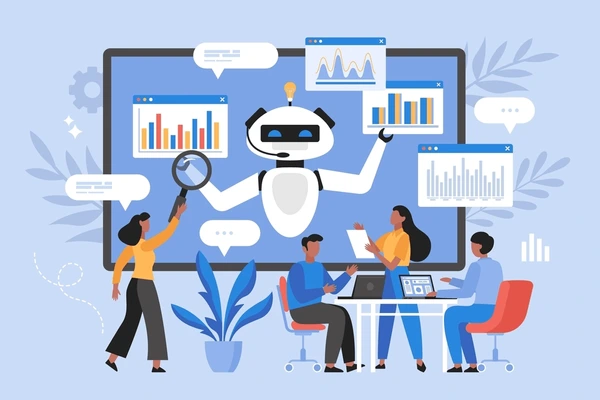AI for Data Analysis: A Beginner’s Guide
Welcome! If you’re just starting out, diving into the world of AI for Data Analysis can seem a bit daunting. But don’t worry! This guide will break down the essentials in a simple, easy-to-understand way. We’ll explore what AI is, how it’s used in data analysis, and how you can begin to learn the ropes.
What is AI in a Nutshell?

At its core, Artificial Intelligence (AI) is about creating computer systems that can perform tasks that typically require human intelligence. These tasks include learning from data, problem-solving, and decision-making. Think about it like teaching a computer to think, learn, and adapt. AI uses algorithms to analyze massive datasets and identify patterns.
Why Use AI for Data Analysis?
Analyzing data manually can be time-consuming and prone to human error. AI offers several advantages, which include:
- Efficiency: AI can process vast amounts of data much faster than humans.
- Accuracy: AI can reduce the chance of errors by automating tasks.
- Automation: It automates tedious tasks.
- Discover New Insights: AI identifies hidden trends and patterns that humans might miss.
Key AI Techniques for Data Analysis
Several AI techniques are particularly useful. Let’s explore some of the most common ones:
Machine Learning (ML)
Machine Learning enables systems to learn from data without being explicitly programmed. In data analysis, ML models are trained to recognize patterns, make predictions, and improve their accuracy over time. Several algorithms are used, which is where you will start to encounter terms like supervised learning, unsupervised learning and Reinforcement learning.
Deep Learning (DL)
Deep Learning is a subset of Machine Learning that uses artificial neural networks to analyze data. These networks, inspired by the human brain, are composed of interconnected layers that process and extract features from data. This is especially useful for image and text analysis. This involves neural networks (algorithms that seek to model relations between data and interpret complex data.)
Natural Language Processing (NLP)
NLP focuses on enabling computers to understand and process human language (text data). NLP techniques are often used to analyze survey responses, customer feedback, and social media data. It can identify sentiment, extract keywords, and summarize large volumes of text. It’s essentially teaching machines to read and comprehend.
Real-World Examples of AI in Data Analysis:
AI is used extensively in different sectors. Here are a few examples to showcase its impact:
- Healthcare: AI algorithms analyze medical images (like X-rays and MRIs) to help diagnose diseases more accurately and efficiently.
- Finance: AI detects fraudulent transactions in real-time, offering protection to customers.
- Retail: Retailers use AI to predict sales trends, optimize inventory, and personalize customer experiences.
- Marketing: AI assists marketers by evaluating marketing campaigns and automating tasks.
The Learning Path: Getting Started with AI for Data Analysis
For beginners, starting small is key. Focus on one area at a time, be it machine learning or natural language processing, and build a solid understanding of the fundamentals. Consider these steps:
- Learn the Basics: Familiarize yourself with programming languages like Python (very popular in data analysis) or R.
- Understand Data: Comprehend the fundamentals regarding data types, data structures and how data is structured.
- Hands-on Projects: Participate in small projects, like a simple prediction from a set of data.
- Online Resources: Take online courses and tutorials (e.g., Coursera, edX, and Kaggle offer many free resources).
- Practice: Apply what you learn by practicing with datasets, such as datasets used in data challenges.
Choosing the Right Tools
Several tools and platforms are available to help you get started. Begin with these beginner-friendly options:
- Python with Libraries: Python, paired with libraries like Pandas (for data manipulation), Scikit-learn (for machine learning), and TensorFlow/PyTorch (for deep learning), is a very popular choice.
- R: R is another popular language, especially among statisticians, with excellent packages for statistical computing and data visualization.
- No-code Platforms: Platforms like Google’s AutoML and Microsoft Azure Machine Learning Studio offer ways to build and deploy AI models without coding.
Ethical Considerations
As you delve into AI for Data Analysis, ethical considerations are extremely important. Be mindful of data privacy, potential biases in your data, and the responsible use of AI results. It’s crucial to analyze data responsibly.
Continuous Learning and Future Trends
The field of AI is constantly evolving. Therefore, you’ll need to stay updated on the latest trends and technologies. Consider exploring areas, such as:
- Explainable AI (XAI): Understanding how AI models make decisions.
- Generative AI: Creating new data (text, images, etc.) based on existing data.
- Federated Learning: Training AI models on decentralized data sources.
Embrace continuous learning by trying new data sets!
